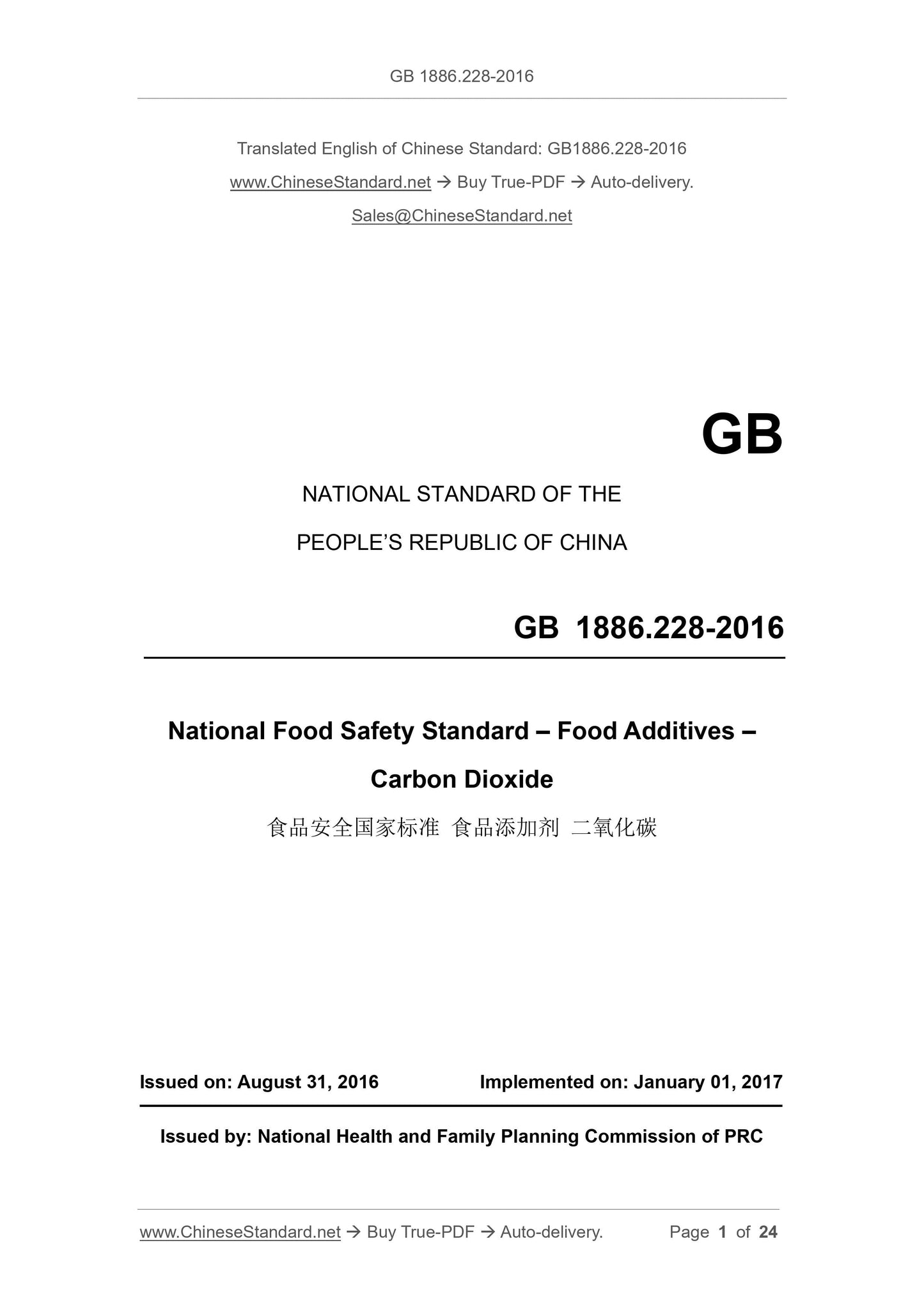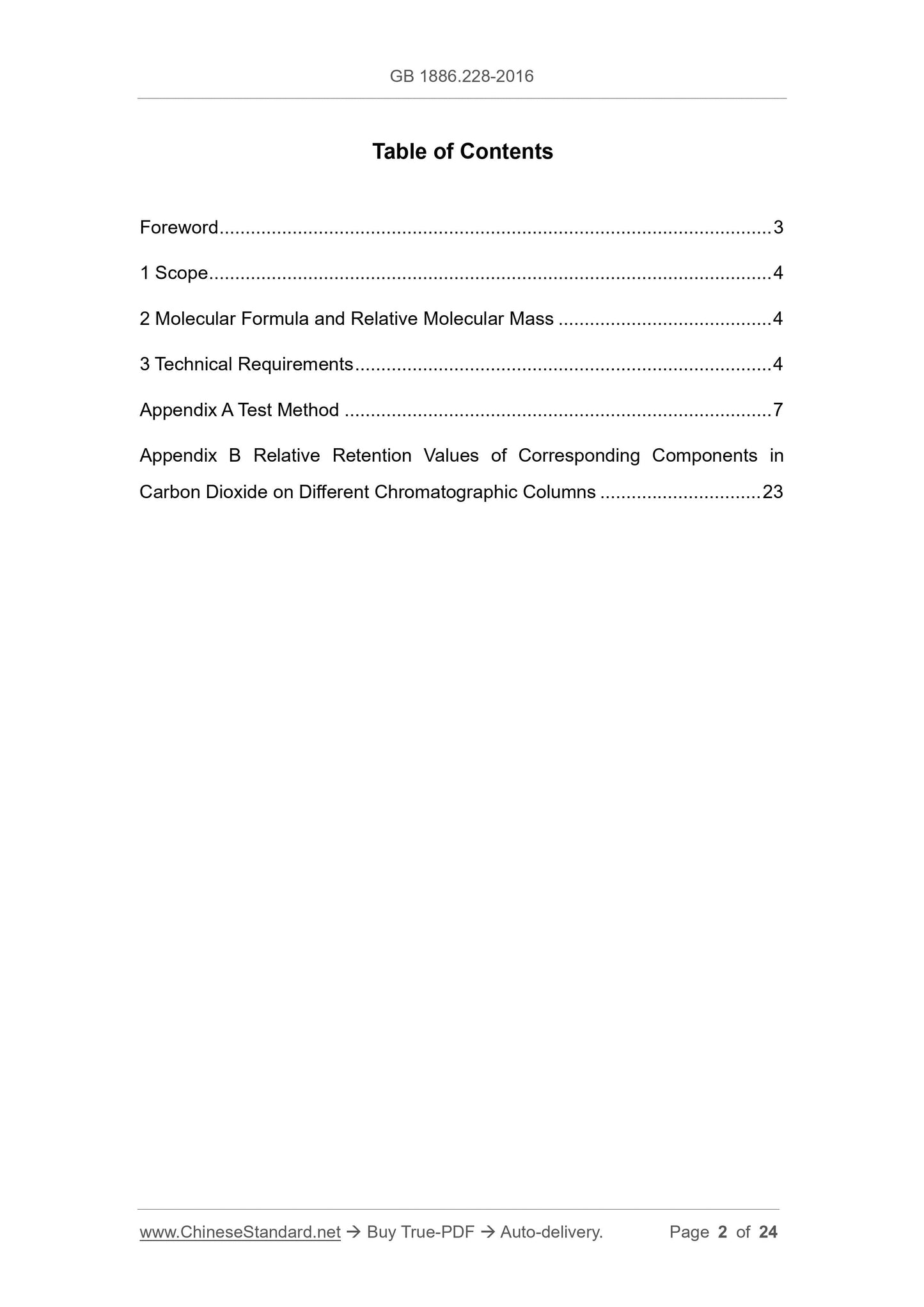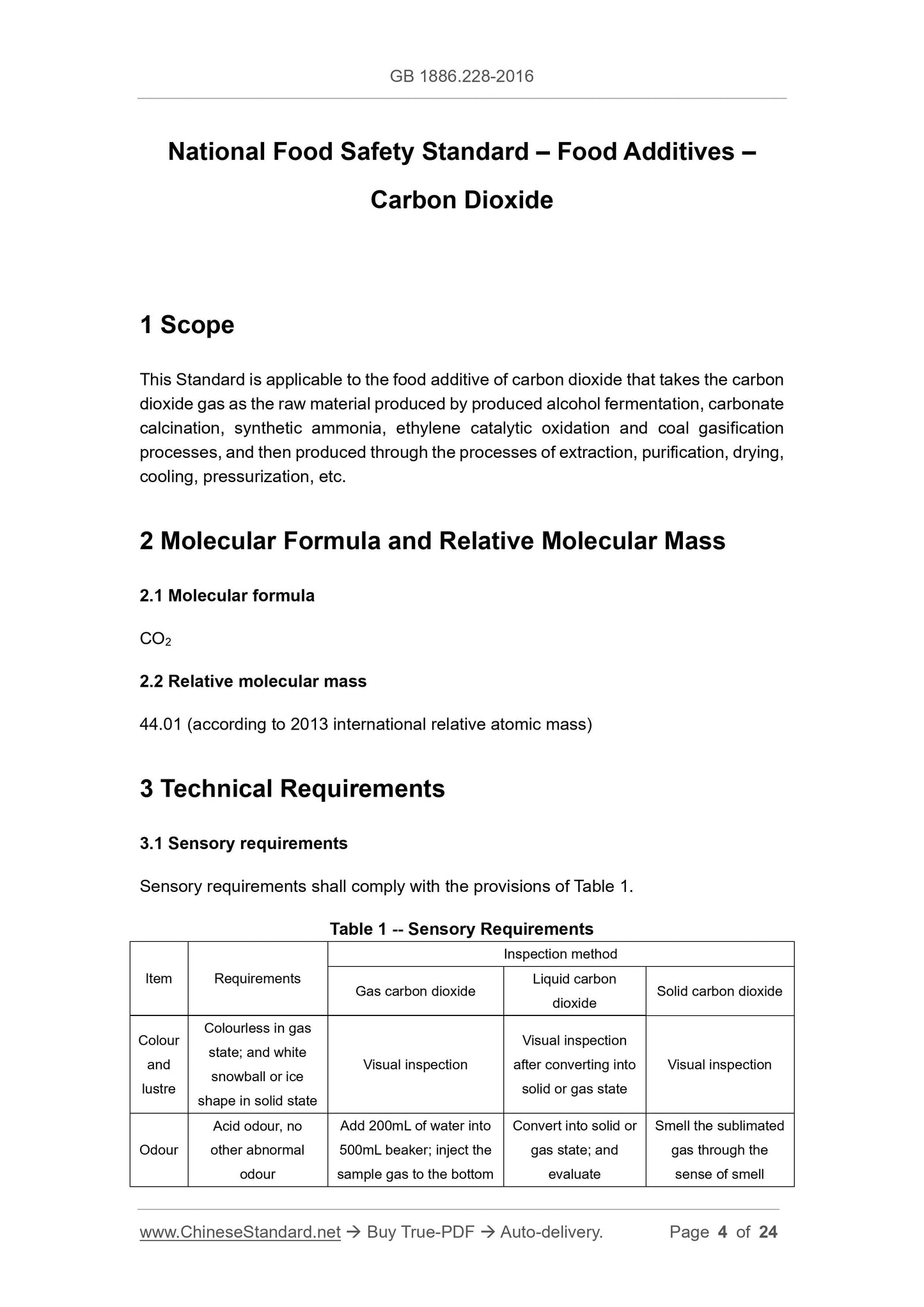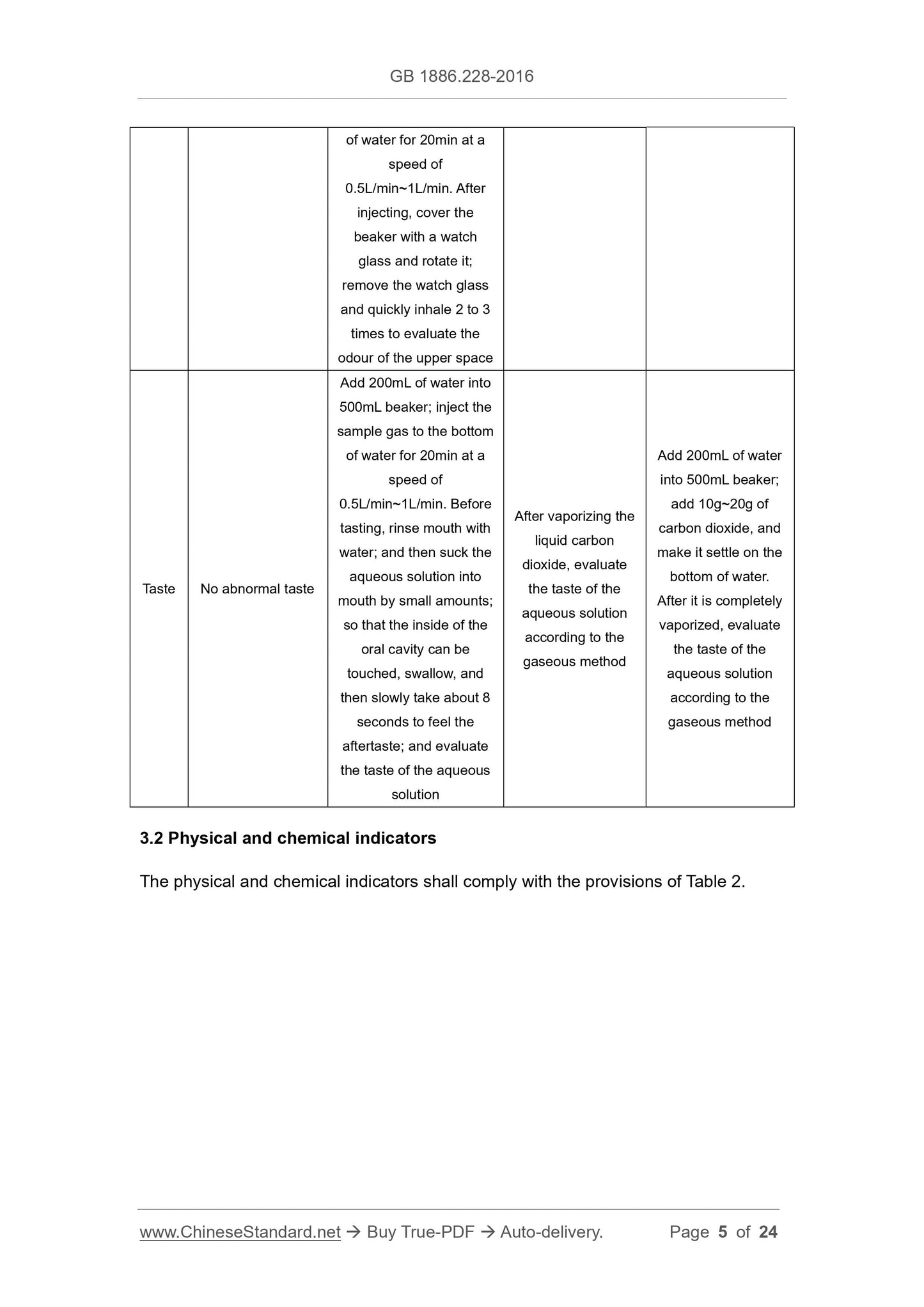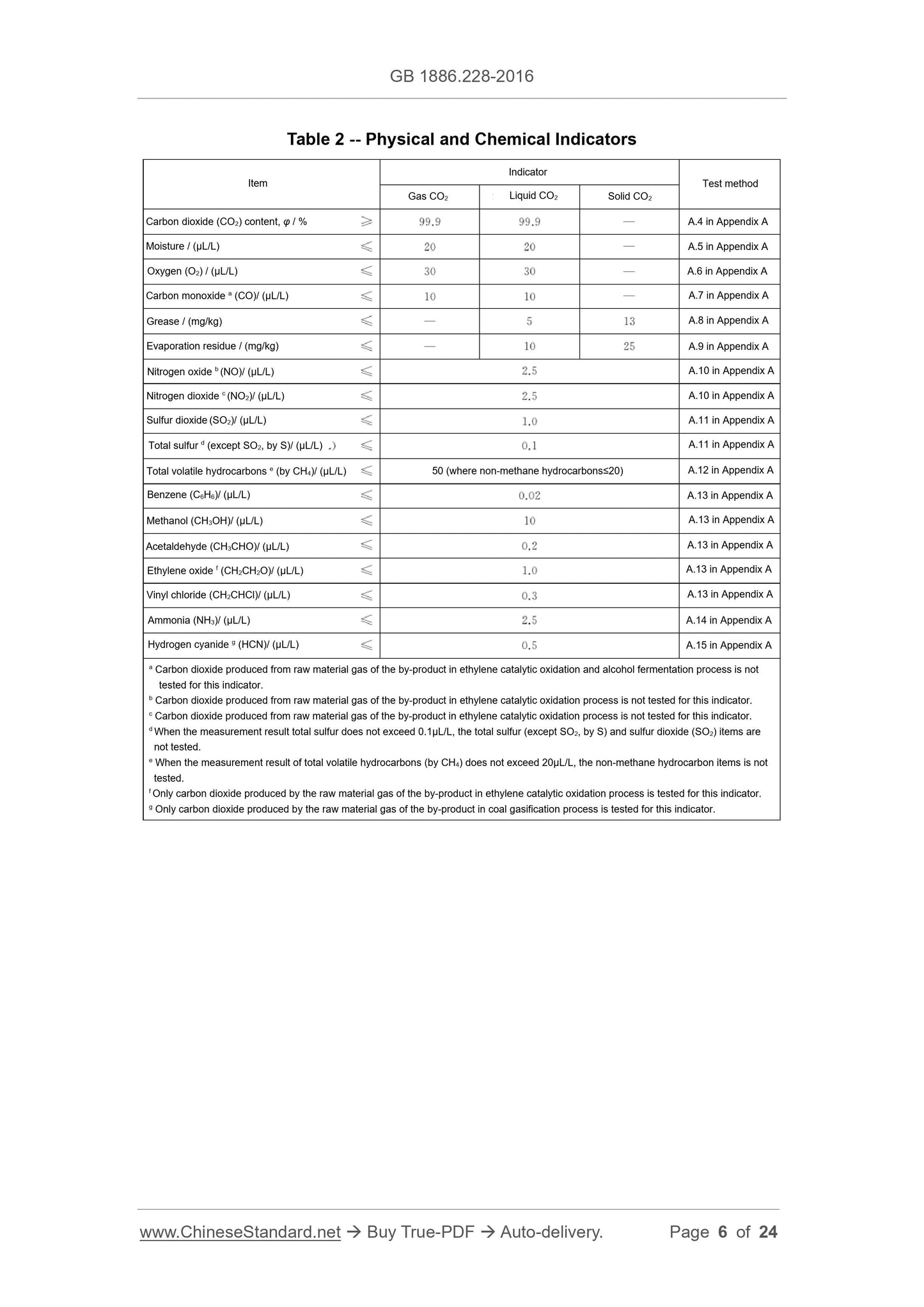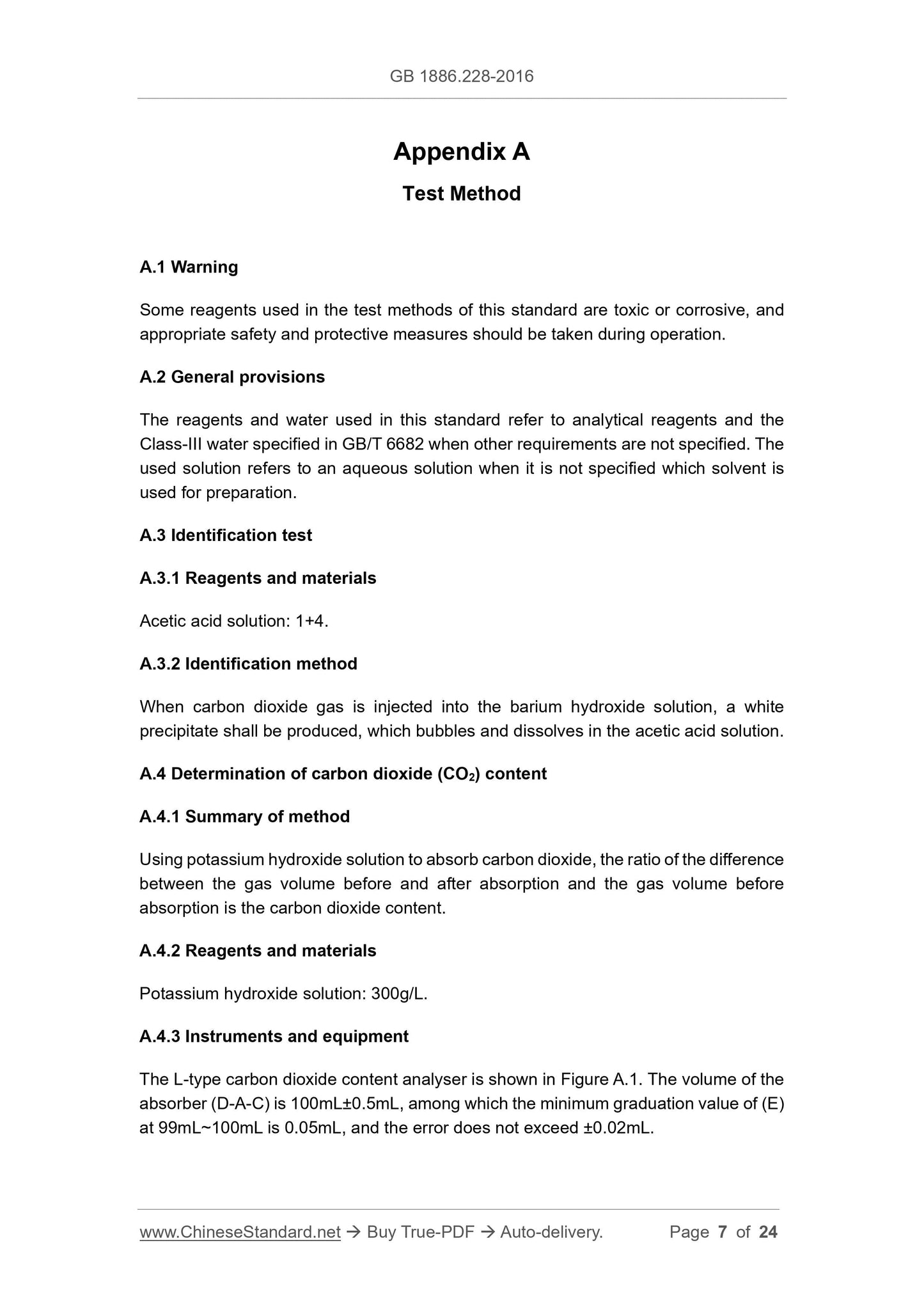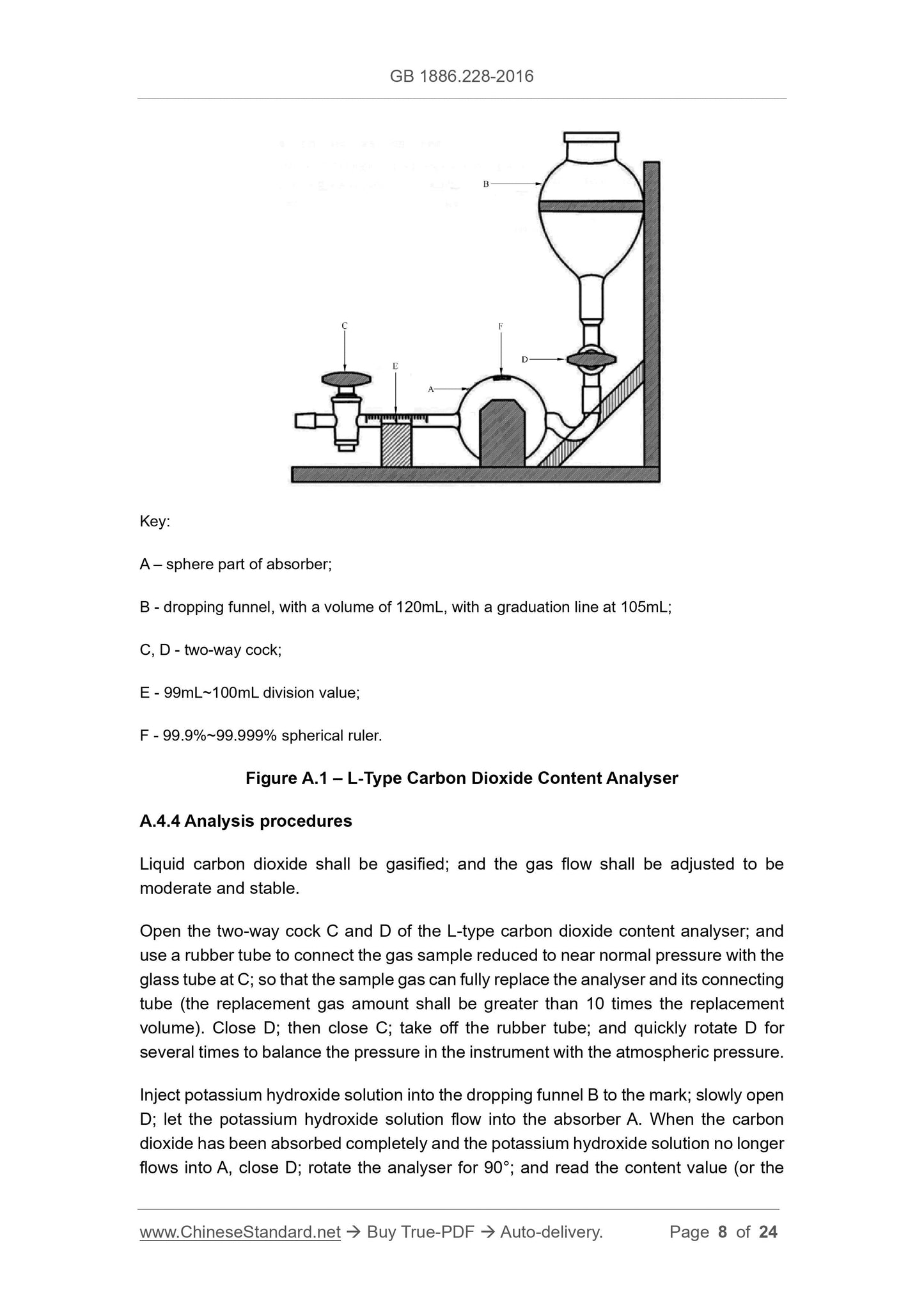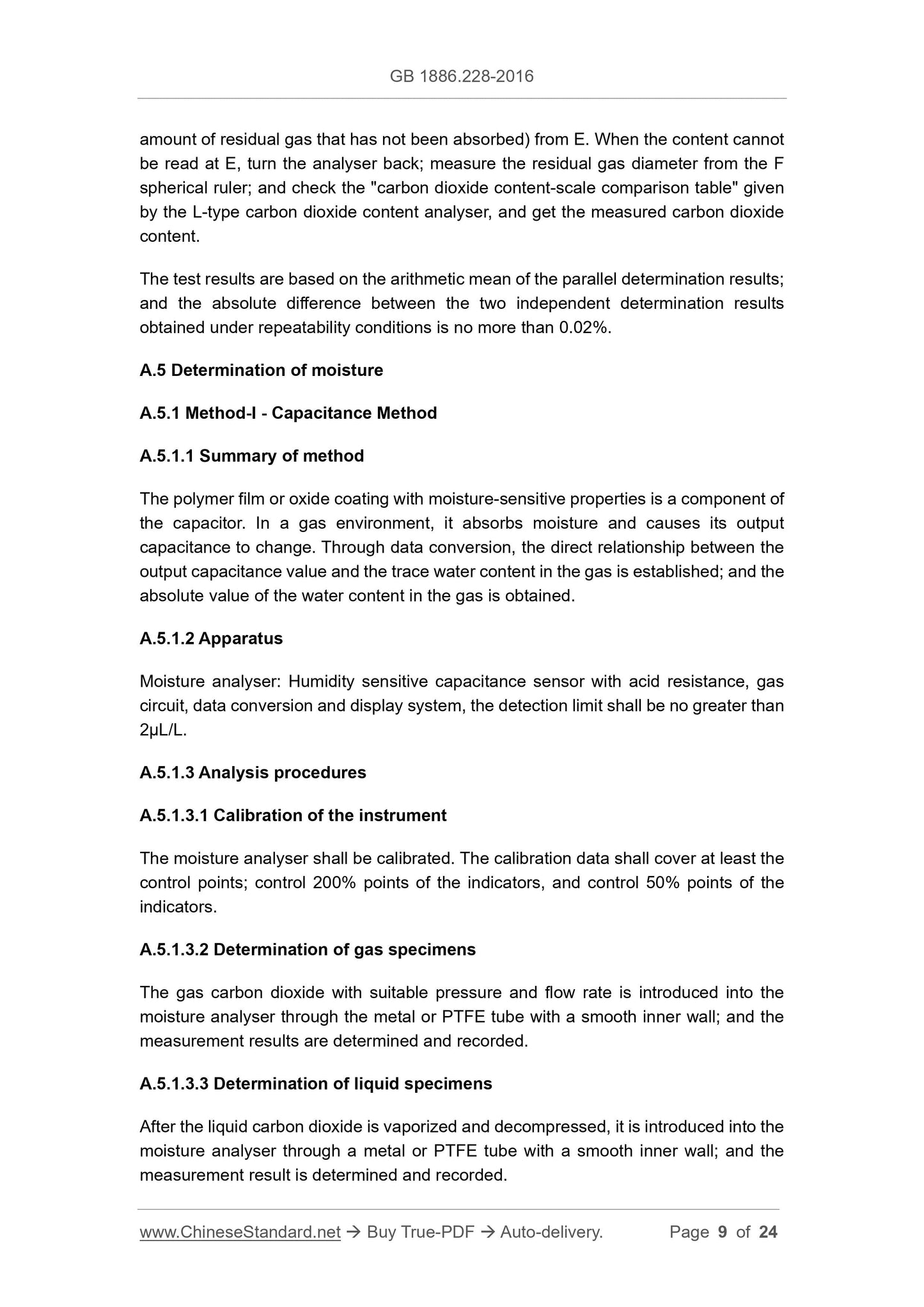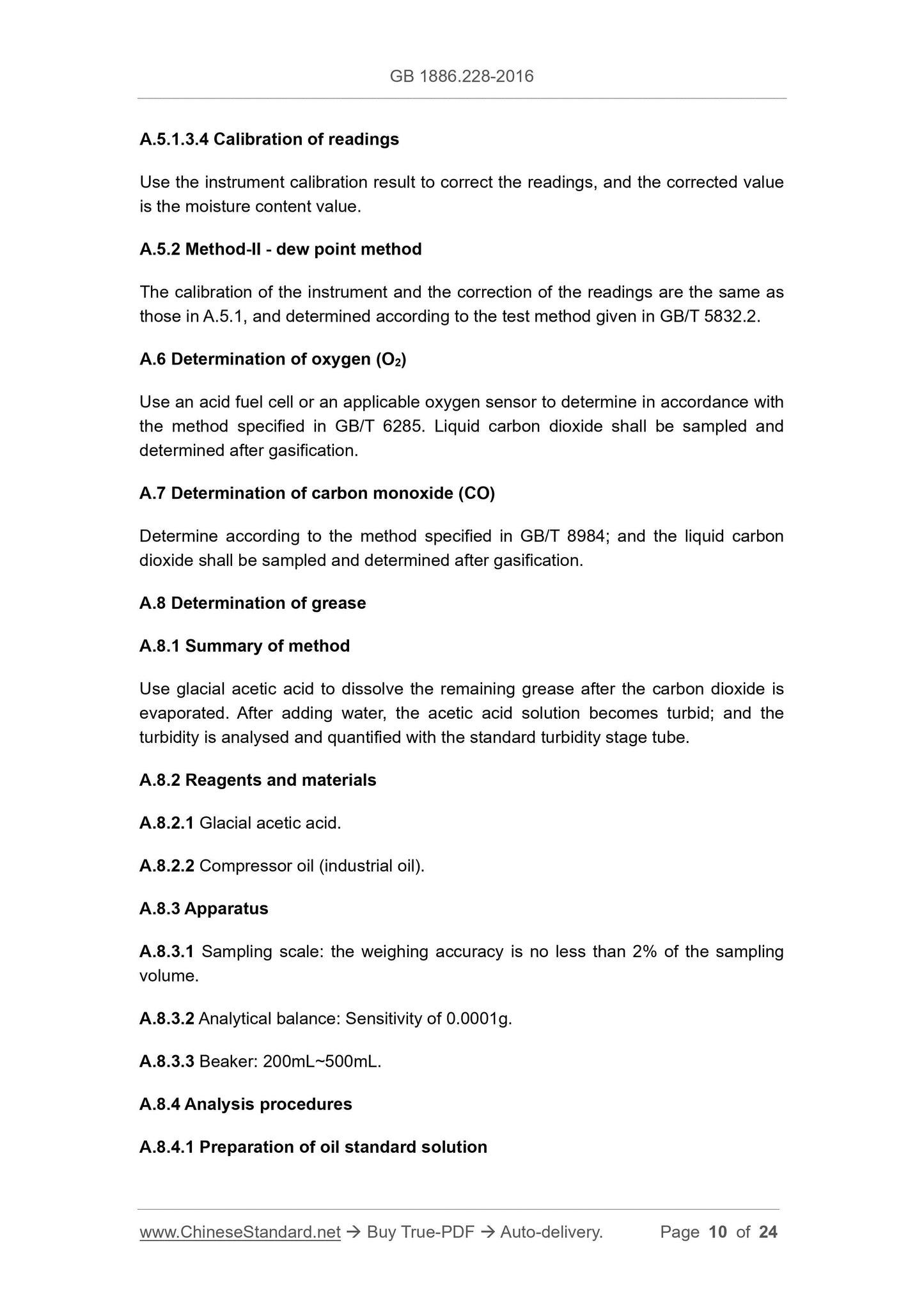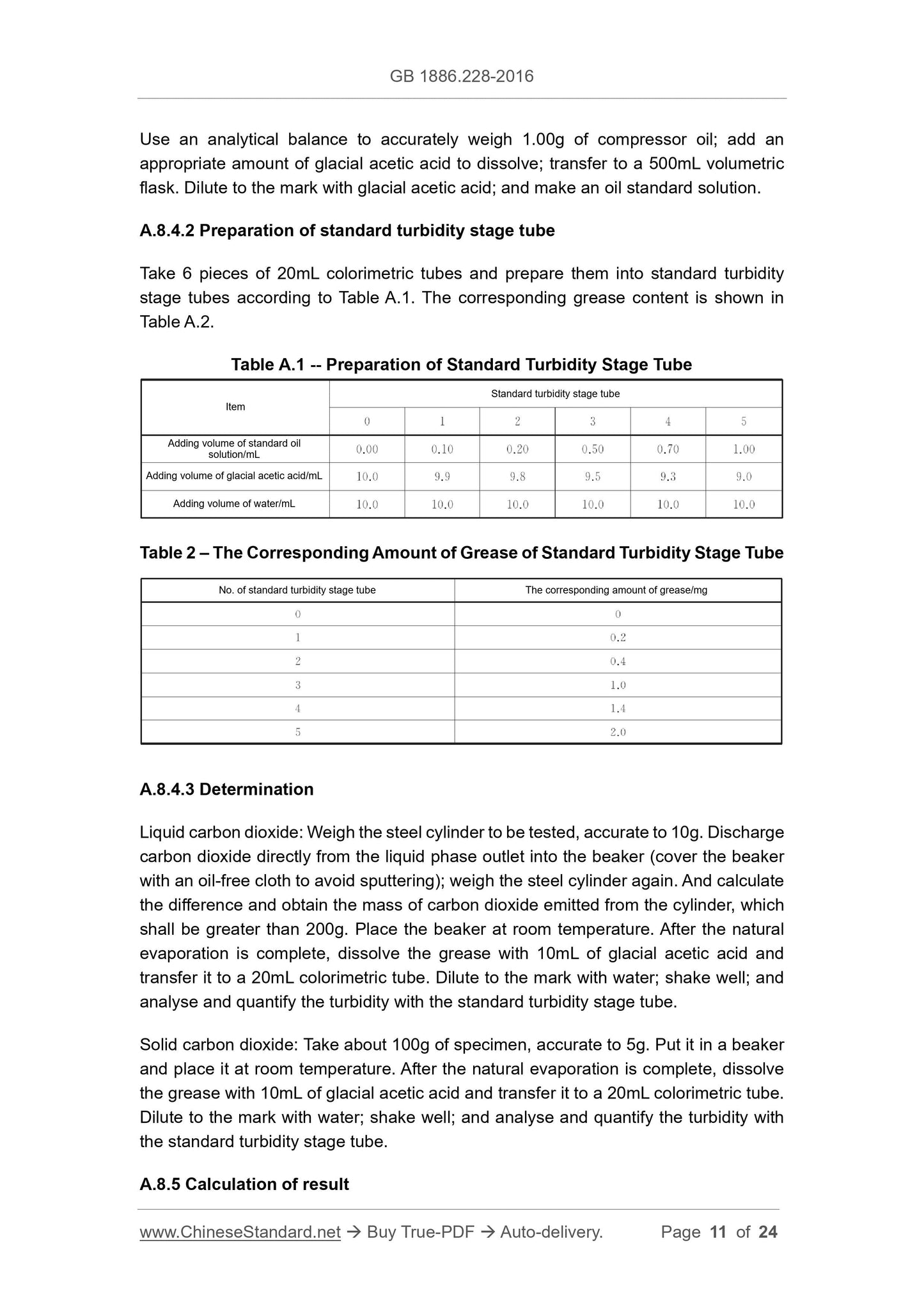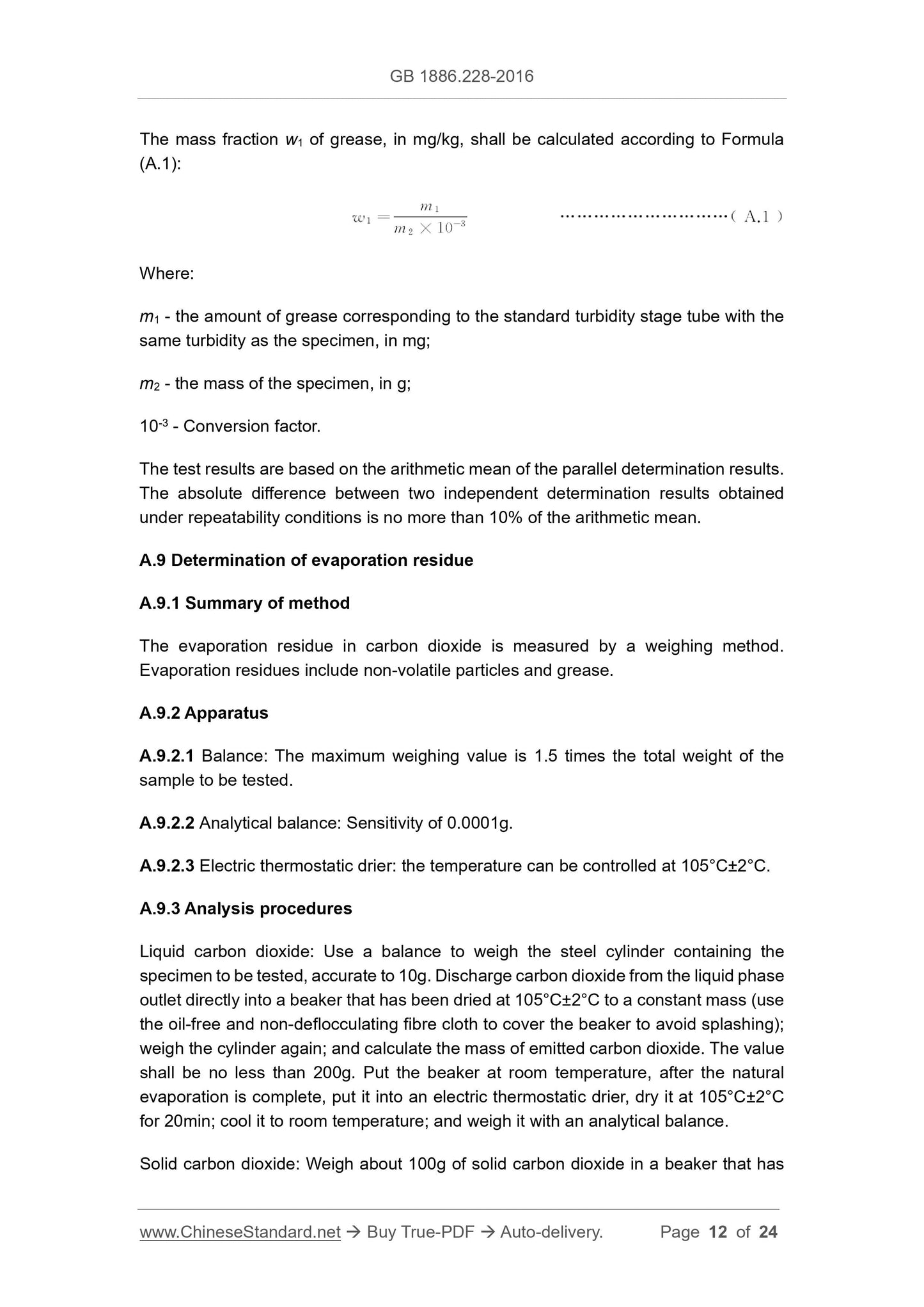1
/
dari
12
PayPal, credit cards. Download editable-PDF & invoice in 1 second!
GB 1886.228-2016 English PDF (GB1886.228-2016)
GB 1886.228-2016 English PDF (GB1886.228-2016)
Harga reguler
$225.00 USD
Harga reguler
Harga obral
$225.00 USD
Harga satuan
/
per
Biaya pengiriman dihitung saat checkout.
Tidak dapat memuat ketersediaan pengambilan
Delivery: 3 seconds. Download true-PDF + Invoice.
Get QUOTATION in 1-minute: Click GB 1886.228-2016
Historical versions: GB 1886.228-2016
Preview True-PDF (Reload/Scroll if blank)
GB 1886.228-2016: Food additive liquid carbon dioxide
GB 1886.228-2016
GB
NATIONAL STANDARD OF THE
PEOPLE’S REPUBLIC OF CHINA
National Food Safety Standard – Food Additives –
Carbon Dioxide
ISSUED ON: AUGUST 31, 2016
IMPLEMENTED ON: JANUARY 01, 2017
Issued by: National Health and Family Planning Commission of PRC
Table of Contents
Foreword ... 3
1 Scope ... 4
2 Molecular Formula and Relative Molecular Mass ... 4
3 Technical Requirements ... 4
Appendix A Test Method ... 7
Appendix B Relative Retention Values of Corresponding Components in
Carbon Dioxide on Different Chromatographic Columns ... 23
National Food Safety Standard – Food Additives –
Carbon Dioxide
1 Scope
This Standard is applicable to the food additive of carbon dioxide that takes the carbon
dioxide gas as the raw material produced by produced alcohol fermentation, carbonate
calcination, synthetic ammonia, ethylene catalytic oxidation and coal gasification
processes, and then produced through the processes of extraction, purification, drying,
cooling, pressurization, etc.
2 Molecular Formula and Relative Molecular Mass
2.1 Molecular formula
CO2
2.2 Relative molecular mass
44.01 (according to 2013 international relative atomic mass)
3 Technical Requirements
3.1 Sensory requirements
Sensory requirements shall comply with the provisions of Table 1.
Appendix A
Test Method
A.1 Warning
Some reagents used in the test methods of this standard are toxic or corrosive, and
appropriate safety and protective measures should be taken during operation.
A.2 General provisions
The reagents and water used in this standard refer to analytical reagents and the
Class-III water specified in GB/T 6682 when other requirements are not specified. The
used solution refers to an aqueous solution when it is not specified which solvent is
used for preparation.
A.3 Identification test
A.3.1 Reagents and materials
Acetic acid solution: 1+4.
A.3.2 Identification method
When carbon dioxide gas is injected into the barium hydroxide solution, a white
precipitate shall be produced, which bubbles and dissolves in the acetic acid solution.
A.4 Determination of carbon dioxide (CO2) content
A.4.1 Summary of method
Using potassium hydroxide solution to absorb carbon dioxide, the ratio of the difference
between the gas volume before and after absorption and the gas volume before
absorption is the carbon dioxide content.
A.4.2 Reagents and materials
Potassium hydroxide solution: 300g/L.
A.4.3 Instruments and equipment
The L-type carbon dioxide content analyser is shown in Figure A.1. The volume of the
absorber (D-A-C) is 100mL±0.5mL, among which the minimum graduation value of (E)
at 99mL~100mL is 0.05mL, and the error does not exceed ±0.02mL.
amount of residual gas that has not been absorbed) from E. When the content cannot
be read at E, turn the analyser back; measure the residual gas diameter from the F
spherical ruler; and check the "carbon dioxide content-scale comparison table" given
by the L-type carbon dioxide content analyser, and get the measured carbon dioxide
content.
The test results are based on the arithmetic mean of the parallel determination results;
and the absolute difference between the two independent determination results
obtained under repeatability conditions is no more than 0.02%.
A.5 Determination of moisture
A.5.1 Method-I - Capacitance Method
A.5.1.1 Summary of method
The polymer film or oxide coating with moisture-sensitive properties is a component of
the capacitor. In a gas environment, it absorbs moisture and causes its output
capacitance to change. Through data conversion, the direct relationship between the
output capacitance value and the trace water content in the gas is established; and the
absolute value of the water content in the gas is obtained.
A.5.1.2 Apparatus
Moisture analyser: Humidity sensitive capacitance sensor with acid resistance, gas
circuit, data conversion and display system, the detection limit shall be no greater than
2μL/L.
A.5.1.3 Analysis procedures
A.5.1.3.1 Calibration of the instrument
The moisture analyser shall be calibrated. The calibration data shall cover at least the
control points; control 200% points of the indicators, and control 50% points of the
indicators.
A.5.1.3.2 Determination of gas specimens
The gas carbon dioxide with suitable pressure and flow rate is introduced into the
moisture analyser through the metal or PTFE tube with a smooth inner wall; and the
measurement results are determined and recorded.
A.5.1.3.3 Determination of liquid specimens
After the liquid carbon dioxide is vaporized and decompressed, it is introduced into the
moisture analyser through a metal or PTFE tube with a smooth inner wall; and the
measurement result is determined and recorded.
A.5.1.3.4 Calibration of readings
Use the instrument calibration result to correct the readings, and the corrected value
is the moisture content value.
A.5.2 Method-II - dew point method
The calibration of the instrument and the correction of the readings are the same as
those in A.5.1, and determined according to the test method given in GB/T 5832.2.
A.6 Determination of oxygen (O2)
Use an acid fuel cell or an applicable oxygen sensor to determine in accordance with
the method specified in GB/T 6285. Liquid carbon dioxide shall be sampled and
determined after gasification.
A.7 Determination of carbon monoxide (CO)
Determine according to the method specified in GB/T 8984; and the liquid carbon
dioxide shall be sampled and determined after gasification.
A.8 Determination of grease
A.8.1 Summary of method
Use glacial acetic acid to dissolve the remaining grease after the carbon dioxide is
evaporated. After adding water, the acetic acid solution becomes turbid; and the
turbidity is analysed and quantified with the standard turbidity stage tube.
A.8.2 Reagents and materials
A.8.2.1 Glacial acetic acid.
A.8.2.2 Compressor oil (industrial oil).
A.8.3 Apparatus
A.8.3.1 Sampling scale: the weighing accuracy is no less than 2% of the sampling
volume.
A.8.3.2 Analytical balance: Sensitivity of 0.0001g.
A.8.3.3 Beaker: 200mL~500mL.
A.8.4 Analysis procedures
A.8.4.1 Preparation of oil standard solution
(CH3CHO), ethylene oxide (CH2CH2O), vinyl chloride (CH2CHCl)
A.13.1 Summary of method
Determine by gas chromatography; the components to be tested in the sample are
separated by the chromatographic column; enter the detector for detection. Be
qualitative based on the retention time; and be quantitative by the external standard
method.
A.13.2 Apparatus
Gas chromatograph: Equipped with hydrogen flame ionization detector or equivalent
detector; the detection limit of benzene is no more than 5×10-3 µL/L.
A.13.3 Reference chromatographic conditions
A.13.3.1 Chromatographic column
Chromatographic column 1: A glass or stainless-steel column with a length of 3m and
an inner diameter of 3mm; packed with a polymer porous pellet (GDX-104) stationary
phase with a diameter of 0.17mm~0.25mm; or a column with equivalent performance;
used for the separation of organic matters.
Chromatographic column 2: A glass or stainless-steel column with a column length of
3m and an inner diameter of 3mm; packed with a diatomaceous earth support of
0.17mm~0.25mm in diameter; coated with 10% polyethylene glycol 20M stationary
phase; or a column with equivalent performance; used for the separation of organic
m...
Get QUOTATION in 1-minute: Click GB 1886.228-2016
Historical versions: GB 1886.228-2016
Preview True-PDF (Reload/Scroll if blank)
GB 1886.228-2016: Food additive liquid carbon dioxide
GB 1886.228-2016
GB
NATIONAL STANDARD OF THE
PEOPLE’S REPUBLIC OF CHINA
National Food Safety Standard – Food Additives –
Carbon Dioxide
ISSUED ON: AUGUST 31, 2016
IMPLEMENTED ON: JANUARY 01, 2017
Issued by: National Health and Family Planning Commission of PRC
Table of Contents
Foreword ... 3
1 Scope ... 4
2 Molecular Formula and Relative Molecular Mass ... 4
3 Technical Requirements ... 4
Appendix A Test Method ... 7
Appendix B Relative Retention Values of Corresponding Components in
Carbon Dioxide on Different Chromatographic Columns ... 23
National Food Safety Standard – Food Additives –
Carbon Dioxide
1 Scope
This Standard is applicable to the food additive of carbon dioxide that takes the carbon
dioxide gas as the raw material produced by produced alcohol fermentation, carbonate
calcination, synthetic ammonia, ethylene catalytic oxidation and coal gasification
processes, and then produced through the processes of extraction, purification, drying,
cooling, pressurization, etc.
2 Molecular Formula and Relative Molecular Mass
2.1 Molecular formula
CO2
2.2 Relative molecular mass
44.01 (according to 2013 international relative atomic mass)
3 Technical Requirements
3.1 Sensory requirements
Sensory requirements shall comply with the provisions of Table 1.
Appendix A
Test Method
A.1 Warning
Some reagents used in the test methods of this standard are toxic or corrosive, and
appropriate safety and protective measures should be taken during operation.
A.2 General provisions
The reagents and water used in this standard refer to analytical reagents and the
Class-III water specified in GB/T 6682 when other requirements are not specified. The
used solution refers to an aqueous solution when it is not specified which solvent is
used for preparation.
A.3 Identification test
A.3.1 Reagents and materials
Acetic acid solution: 1+4.
A.3.2 Identification method
When carbon dioxide gas is injected into the barium hydroxide solution, a white
precipitate shall be produced, which bubbles and dissolves in the acetic acid solution.
A.4 Determination of carbon dioxide (CO2) content
A.4.1 Summary of method
Using potassium hydroxide solution to absorb carbon dioxide, the ratio of the difference
between the gas volume before and after absorption and the gas volume before
absorption is the carbon dioxide content.
A.4.2 Reagents and materials
Potassium hydroxide solution: 300g/L.
A.4.3 Instruments and equipment
The L-type carbon dioxide content analyser is shown in Figure A.1. The volume of the
absorber (D-A-C) is 100mL±0.5mL, among which the minimum graduation value of (E)
at 99mL~100mL is 0.05mL, and the error does not exceed ±0.02mL.
amount of residual gas that has not been absorbed) from E. When the content cannot
be read at E, turn the analyser back; measure the residual gas diameter from the F
spherical ruler; and check the "carbon dioxide content-scale comparison table" given
by the L-type carbon dioxide content analyser, and get the measured carbon dioxide
content.
The test results are based on the arithmetic mean of the parallel determination results;
and the absolute difference between the two independent determination results
obtained under repeatability conditions is no more than 0.02%.
A.5 Determination of moisture
A.5.1 Method-I - Capacitance Method
A.5.1.1 Summary of method
The polymer film or oxide coating with moisture-sensitive properties is a component of
the capacitor. In a gas environment, it absorbs moisture and causes its output
capacitance to change. Through data conversion, the direct relationship between the
output capacitance value and the trace water content in the gas is established; and the
absolute value of the water content in the gas is obtained.
A.5.1.2 Apparatus
Moisture analyser: Humidity sensitive capacitance sensor with acid resistance, gas
circuit, data conversion and display system, the detection limit shall be no greater than
2μL/L.
A.5.1.3 Analysis procedures
A.5.1.3.1 Calibration of the instrument
The moisture analyser shall be calibrated. The calibration data shall cover at least the
control points; control 200% points of the indicators, and control 50% points of the
indicators.
A.5.1.3.2 Determination of gas specimens
The gas carbon dioxide with suitable pressure and flow rate is introduced into the
moisture analyser through the metal or PTFE tube with a smooth inner wall; and the
measurement results are determined and recorded.
A.5.1.3.3 Determination of liquid specimens
After the liquid carbon dioxide is vaporized and decompressed, it is introduced into the
moisture analyser through a metal or PTFE tube with a smooth inner wall; and the
measurement result is determined and recorded.
A.5.1.3.4 Calibration of readings
Use the instrument calibration result to correct the readings, and the corrected value
is the moisture content value.
A.5.2 Method-II - dew point method
The calibration of the instrument and the correction of the readings are the same as
those in A.5.1, and determined according to the test method given in GB/T 5832.2.
A.6 Determination of oxygen (O2)
Use an acid fuel cell or an applicable oxygen sensor to determine in accordance with
the method specified in GB/T 6285. Liquid carbon dioxide shall be sampled and
determined after gasification.
A.7 Determination of carbon monoxide (CO)
Determine according to the method specified in GB/T 8984; and the liquid carbon
dioxide shall be sampled and determined after gasification.
A.8 Determination of grease
A.8.1 Summary of method
Use glacial acetic acid to dissolve the remaining grease after the carbon dioxide is
evaporated. After adding water, the acetic acid solution becomes turbid; and the
turbidity is analysed and quantified with the standard turbidity stage tube.
A.8.2 Reagents and materials
A.8.2.1 Glacial acetic acid.
A.8.2.2 Compressor oil (industrial oil).
A.8.3 Apparatus
A.8.3.1 Sampling scale: the weighing accuracy is no less than 2% of the sampling
volume.
A.8.3.2 Analytical balance: Sensitivity of 0.0001g.
A.8.3.3 Beaker: 200mL~500mL.
A.8.4 Analysis procedures
A.8.4.1 Preparation of oil standard solution
(CH3CHO), ethylene oxide (CH2CH2O), vinyl chloride (CH2CHCl)
A.13.1 Summary of method
Determine by gas chromatography; the components to be tested in the sample are
separated by the chromatographic column; enter the detector for detection. Be
qualitative based on the retention time; and be quantitative by the external standard
method.
A.13.2 Apparatus
Gas chromatograph: Equipped with hydrogen flame ionization detector or equivalent
detector; the detection limit of benzene is no more than 5×10-3 µL/L.
A.13.3 Reference chromatographic conditions
A.13.3.1 Chromatographic column
Chromatographic column 1: A glass or stainless-steel column with a length of 3m and
an inner diameter of 3mm; packed with a polymer porous pellet (GDX-104) stationary
phase with a diameter of 0.17mm~0.25mm; or a column with equivalent performance;
used for the separation of organic matters.
Chromatographic column 2: A glass or stainless-steel column with a column length of
3m and an inner diameter of 3mm; packed with a diatomaceous earth support of
0.17mm~0.25mm in diameter; coated with 10% polyethylene glycol 20M stationary
phase; or a column with equivalent performance; used for the separation of organic
m...
Share
